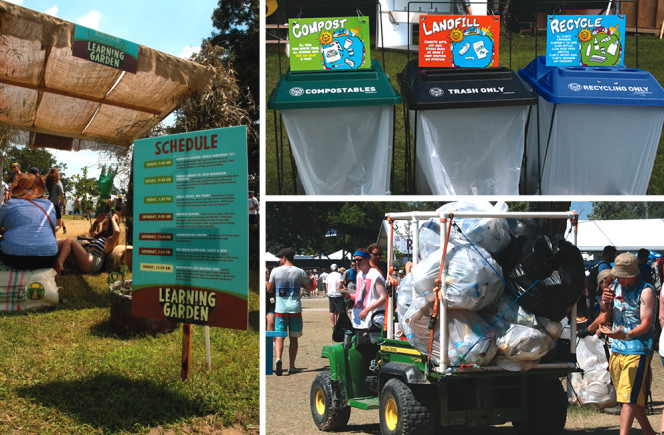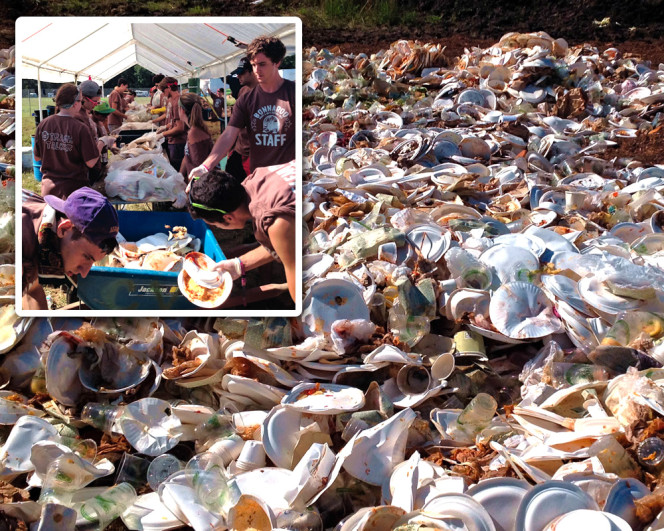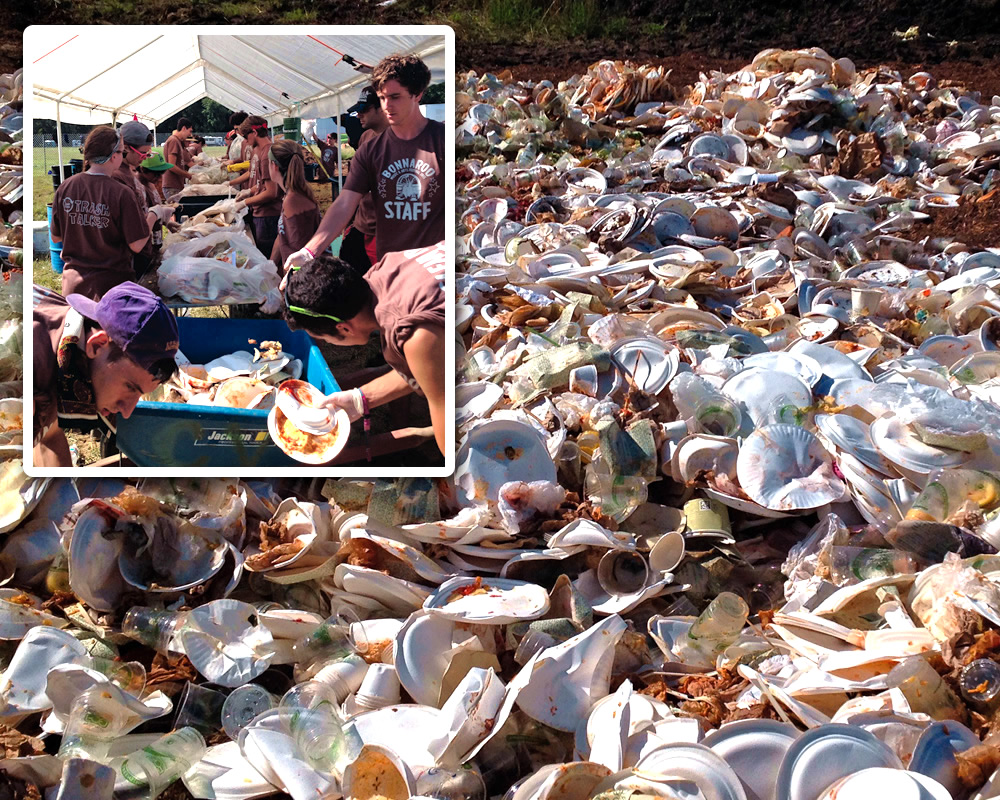This year’s Bonnaroo Music & Arts festival, attended by over 80,000 people, generated 120 tons of compostable material being processed on-site.
Stephanie Katsaros
BioCycle September 2014

The Learning Garden (left) teaches festival attendees about composting and compost use, and organic food production. Bonnaroo began source separation of organics the first year the festival was held in 2002, and has continued it ever since (sorting station, top). Organics are collected in compostable bags and transported bottom) to the on-site composting operation. Photos by Stephanie Katsaros
The Bonnaroo Music & Arts festival — one of the most iconic large-scale music festivals in the world — is held annually on a 700-acre farm in Man-chester, Tennessee. This four-day event features more than 150 artists on a dozen stages, and a commitment to environmentally-conscious production practices. This year’s fest generated 120 tons of compostable material being composted on-site.
Bonnaroo began in 2002 as a multigenre music festival with on-site camping and music ‘til sunrise, a popular concept in Europe, but something the U.S. hadn’t seen since Woodstock. From legends to up-and-comers, Bonnaroo has featured a diverse range of artists, including Paul McCartney, Dave Matthews, Stevie Wonder, Metallica, Radiohead, Jay-Z, Bob Dylan, Pearl Jam and Phish. During the four days each year, Bonnaroo is the biggest city in Tennessee, yet somehow these 80,000-plus individuals (including fans, workers, artists and volunteers) quickly foster a deep sense of community that has carried through each of its 13 years. Since its inception, organizers of Bonnaroo felt it was their responsibility to invest in environmental sustainability. Over time, this investment of time, money, manpower and experimentation has proven successful.
Enlisting the help of Clean Vibes, a company formed and dedicated to responsible on-site waste management of many outdoor festivals and events, Bonnaroo was launched with waste reduction as a core operating principle. Managing waste material behind the scenes was key, but Clean Vibes also incentivized fans to collect littered recyclables through a recycling raffle. Fans can turn in recyclable items to the Clean Vibes Trading Post booth, collect points for each piece, and later redeem their points for “prizes,” such as sunscreen, t-shirts, artist merchandise, and free tickets to future events. Programs like these allow fans to directly participate in event sustainability, take pride in the festival’s eco-focused production, and effectively build the backbone of the festival’s conscious community. Laura Sohn, Director of Sustainability for Bonnaroo, sees community building as the key to its accomplishments in waste diversion.
Source separation of organics began the first year Bonnaroo was held (2002). Material collected — primarily food scraps — was sent to regional composting facilities. Compostable cups were introduced as a vendor requirement in 2003, and compostable food service items in 2004. With these advances in procurement, a pilot on-site composting program was implemented in 2004. Combined with recycling figures, 120 tons of organics and recyclables were diverted in 2004, and 80 combined tons were diverted in 2005.
Vendor Requirements
In 2006, Bonnaroo organizers bought the farm… literally! This allowed for the planning of on-site composting, as well as future projects like installation of a solar array. Waste reduction education, including composting and recycling, was made available in the campground to improve diversion in that area. The festival’s Concession Team began to enforce vendor requirements, with threats of kicking out those caught by “zone managers” for using anything other than the required compostable food serviceware. Communication with vendors begins months ahead, and given Bonnaroo’s location, it is necessary to stock up before arriving at the farm. Sohn points to a higher level of expectation and understanding in terms of vendor participation in composting requirements, which aligns with Bonnaroo’s consistent environmental message and strong vendor relationships. As the festival’s popularity and reputation have grown, vendors understand that in order to have access, they must comply.
Eco-Products, the maker of the compostable plates, cups and utensils used at Bonnaroo, works closely with the organizers to ensure vendors comply with purchasing guidelines set forth by the festival. The company provides vendors access to an online portal for ordering a select and specially priced list of Eco-Products compostable items, simplifying procurement. Bonnaroo’s exclusive partnership with Eco-Products reduces the risk of contamination from other biobased items that are not truly compostable, and also aligns with Eco-Products’ desire to associate with successful zero waste partners, such as festivals, ballparks and corporate campuses. “We want to tell the food service world ‘this actually works,’ and we are working on the ground-floor level to see it through to success,” explains Wendell Simonson, Eco-Products vice-president of marketing. “There’s nothing better than seeing our cups and plates go from serving thousands of festivalgoers to serving a farm composting operation.”
In addition to these expanded diversion steps, the level of detail in Bonnaroo’s reporting was enhanced in 2006; 10.63 tons were composted and 73.49 tons recycled, and an overall total of 202.96 tons were “put somewhere more productive than a landfill,” says Sohn. The nonspecified material included donation-worthy camper waste such as tents and other items left on-site, and operational waste such as wood, rebar and vinyl tarp with a potentially useful second life.
Building a community around sustainability, Bonnaroo began a “Green Ambassadors” program in 2007, with a team of volunteers empowered to spread the message of the festival’s earth-friendly production practices. It also launched the presentation of environmentally focused documentaries in the popular (and air-conditioned) Movie Tent, to inspire and motivate fans to get involved. The 2007 event resulted in 10.3 tons of organics, 47.17 tons of recyclables, and 300.2 tons of overall material diverted from the landfills.
On-Site Composting
Bonnaroo organizers launched on-site composting in 2008 to eliminate the fuel consumption, pollution and costs associated with transport of organics, as well as to bring the program full-circle. The composting method is simple: A tractor mixes the food waste and compostable food service items with wood chips continuously during the festivals, forming a large pile on a compost pad on the farm. The final pile is estimated to contain 120 tons of diverted organics, and four to five truckloads of wood chips each year. After the throngs of fans leave the farm, a groundskeeper turns the pile once every few months using an excavator or a large tractor. The event takes place in mid-June, and Clean Vibes founder, Anna Borofsky, explains that by early March, “other than the few things on the outside of the pile, everything is pretty much turned to compost.” The biggest challenge she deals with on the sorting side is minuscule noncompostable items, like butter packets, which often find their way into the stream.
Bonnaroo compost is used on-site, and for the local Keep America Beautiful (KAB) chapter, Keep Coffee County Beautiful (KCCB) projects. (Man-chester is in Coffee County, Tennessee.) While interacting with fans at the KAB tent in the “Planet Roo” Eco-Village, Tanya Wilkinson, KCCB executive coordinator, explained her vision for partnering with Bonnaroo: “Coffee County is challenged to start its own composting program. This (partnership) is a pilot and awareness builder for composting and responsible waste reduction overall.” The county building’s flowerbed is enhanced by Bonnaroo’s nutrient-rich compost, providing tangible proof of the benefits of using this soil amendment.
Trash Talkers
Also in 2008, Clean Vibes introduced a staff of over 300 “Trash Talkers” positioned at over 100 stations throughout the festival grounds to help fans learn and hopefully adopt proper disposal practices. That meant buying over 300 bins, which Sohn says, “is an expense that pays for itself. Labor would go up if it wasn’t sorted front-of-house, and we are committed to making sure we divert as much as possible.”

Volunteers manually sift through each waste stream at a rudimentary sorting station to remove cross-contamination (inset). Compostable plates, cups and utensils are used at Bonnaroo (shown at composting farm). Vendors are provided purchasing guidelines set forth by the festival. Photos courtesy of Clean Vibes
Behind the scenes, Clean Vibes created a rudimentary sorting station where volunteers manually sift through each waste stream to remove cross-contamination. And immediately after each year’s festival, this team performs a line-sweep, walking shoulder-to-shoulder in a grid pattern, picking up everything.
In 2009, Bonnaroo added water stations to reduce consumption of bottled water while keeping fans hydrated. It also planted a “Learning Garden” to teach about composting and compost use and organic food production. This also was the inaugural year of Bonnaroo’s optional “Green Ticket” fee, to which an impressive 40 percent of purchasers contributed, raising $25,000. That amount equals the average funds raised annually to support on-site projects such as the compost pad, solar array, community dinners and local eco-housing projects.
At the 2009 event, 30 tons of organics and 127.74 tons of recyclables were diverted. In subsequent years, reporting became even more detailed, with Bonnaroo demonstrating transparency not only in what materials were generated, but also which companies received the diverted material.
Fast-forward to 2014, and the Bonnaroo team achieved 67 percent diversion by weight. Borofsky estimates this includes 120 tons of organics and 211.38 tons of recyclables — including commingled recyclables, cardboard, scrap metal and waste oil. It’s a success story in waste diversion that helps demonstrate the economic and operational feasibility of such large-scale measures.
Community Impact
Having a city-sized crowd engulf the small town of Manchester for almost one week every year has its challenges, but Bonnaroo has more than made up for the inconvenience. Its partnership with We Are Neutral, Manchester Housing Authority, Duck River Electric utility and scores of volunteers has provided efficiency measures in low-income homes in the area, saving residents hundreds of thousands of dollars on utility costs. The energy efficiency work is performed during the year using money generated from the green fee to support it. Bonnaroo also donates money to local groups such as Keep Coffee County Beautiful. “The community is integral to this festival,” says Jeff Cuellar, vice-president of strategic partnership for AC Entertainment, co-creators of Bonnaroo. “Their hospitality and culture are part of what makes Bonnaroo special.”
And the community clearly welcomes them, presenting Cuellar with a key to the city — and county — that he accepted alongside legendary performer, Lionel Richie. “It’s a true testament to the community embracing Bonnaroo and its performers, and appreciating our stewardship,” he adds.
Litter Prevention
Keep America Beautiful has been a Bonnaroo partner for four years, engaging 2014 fans in its campaign to stop cigarette butts litter. “Blame it on Humphrey Bogart’s inimitable flick,” says Bronwen Evans, program director at KAB, when explaining why people think it’s appropriate to flick a butt on the ground instead of extinguishing it and putting it in a receptacle. “Litter begets litter,” she adds, referring to cigarette butts as “gateway litter.” KAB research shows that 18 to 35 year olds are the biggest littering demographic, an important fact to consider when targeting behavior change campaigns.
Focus On Food
Bonnaroo has worked with Grundy County Food Bank for several years to recover perishable and nonperishable food from meal catering for performers, staff catering and VIP areas. The festival is now working with vendors to communicate in advance if they want post-show pick ups of unused food, and possibly daily pick ups as well. It is a detailed process, but one which supports the vital cause of Food Justice, described by Bob Ferguson of OXFAM as “getting food into the hands of the people who need it.” OXFAM’s presence at Bonnaroo this year culminated on the Solar (powered) Stage, where music by the Black Lillies merged with a conversation on food inequality and helping people realize better ways to produce, eat and dispose of (if you have to) food.
In 2014, things came full-circle at the sold out BonnaROOTS Community Dinners, held nightly at the fest. Eat for Equity’s Emily Torgrimson coordinates these dinners to help people share a meal and a common cause, and to build community and a sense of giving. Volunteer chefs prepared healthy meals from locally-farmed meats and produce, along with herbs and vegetables grown with compost-amended soil in the Learning Garden.
Stephanie Katsaros, BioCycle contributor, is founder of Bright Beat, which specializes in large-scale sustainability solutions for brands, events, venues and municipalities.This article a first-hand account of her behind-the-scenes involvement at Bonnaroo.














